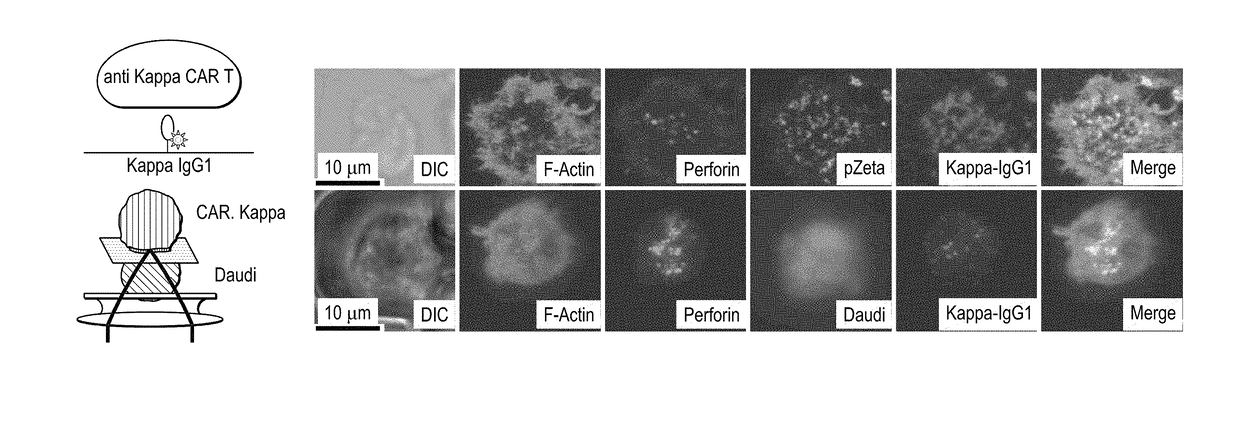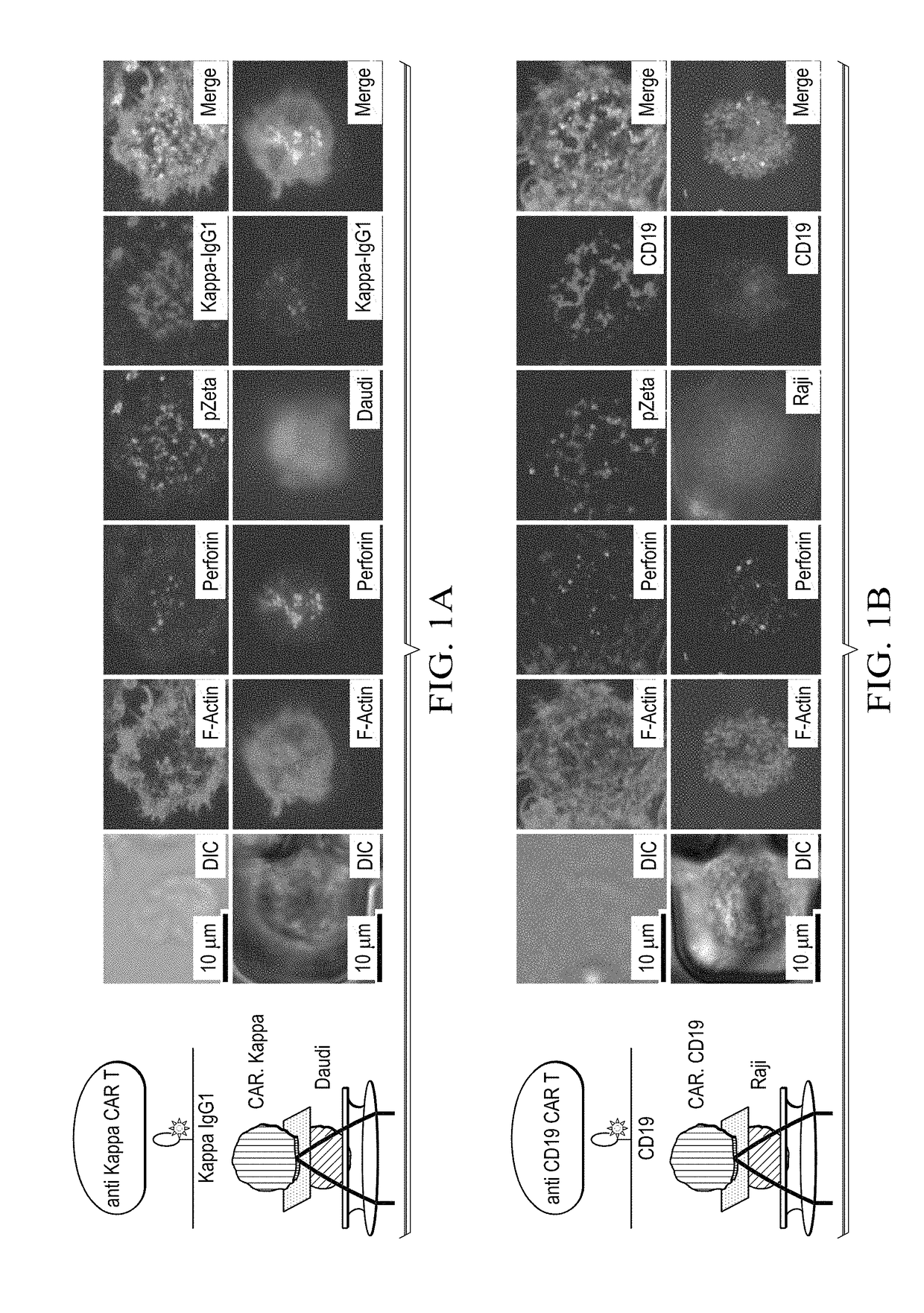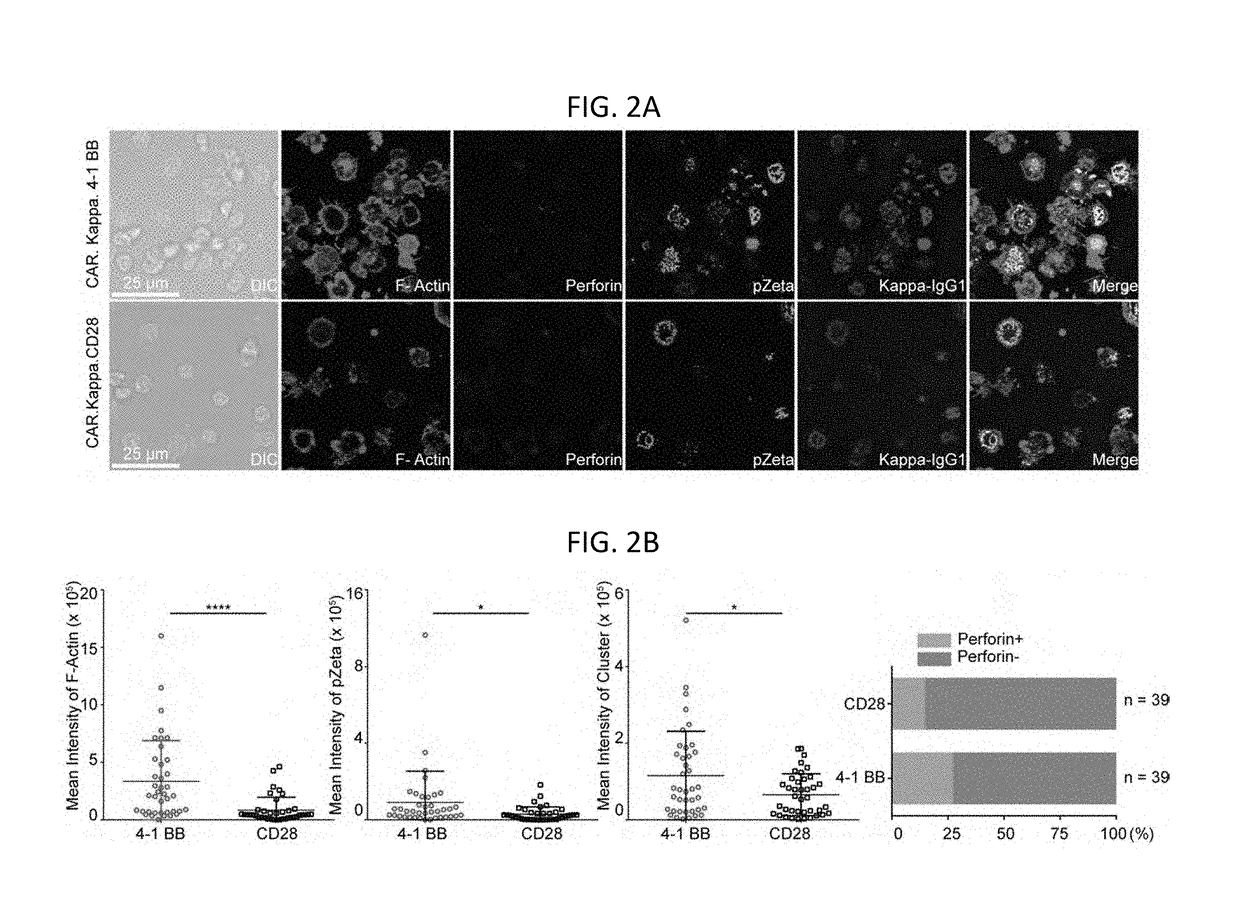Quality of immunological synapse predicts effectiveness of chimeric antigen receptor (CAR) t cells
- Summary
- Abstract
- Description
- Claims
- Application Information
AI Technical Summary
Benefits of technology
Problems solved by technology
Method used
Image
Examples
example 1
Visualization of CAR T Synapse by Two Complementary Systems
[0093]To test whether CAR T cells can form a stable IS, both kappa-CAR and CD19-CAR were added to the glass-supported planar lipid bilayers carrying fluorescently labeled kappa and CD19 tumor antigen, respectively. The CAR constructs were described previously. Briefly, a retroviral vector containing the single-chain antibody against the CD19 molecule or kappa chain protein, the CD28 intracellular domain (hereinafter referred to as CD28-CAR) or CD28 intracellular domain linked with 4-1BB endodomain (hereinafter referred to as 4-1BB-CAR), and the zeta chain of TCR. Kappa-CAR and CD19-CAR share the same intracellular domains, as shown in FIG. 11. The distributions of CAR were imaged by 3-dimensional (3D) STED super-resolution microscopy (FIG. 1). Images of fixed CAR T cells on lipid bilayers revealed a central accumulation of kappa and CD19 under each CAR T cell, which is reminiscent of the central cluster of the T-cell recepto...
example 2
Standard CR51 Release Assay and Cytokine Secretion Cannot Distinguish the Difference Between 4-1BB-CAR and CD28-CAR T Cells
[0098]Optimal function of T cells depends on the quality of the synapse. Given the superior quality of the synapse built by 4-1BB-CAR T cells, in one embodiment 4-1BB-CAR T cells can elicit better killing activity against their susceptible tumor cells. To test this consideration, the standard 4-hour Cr51 release assay was used to measure the cytotoxicity of CAR T cells, as well as intracellular cytokine secretion. Comparing the cytotoxicity of 4-1BB-CAR T cells and CD28-CAR T cells, both 4-1BB-CAR T and CD28-CAR T cells efficiently killed their susceptible tumor cells (FIG. 3a). However, both 4-1BB CAR T and CD28-CAR T cells displayed the similar activity against three different kappa chain positive tumor cell lines: Daudi, JEKO1, and BJAB cells (FIG. 3a). Similar results were obtained in CD19-CAR T cells against two CD19 positive tumor cell lines—Raji and Daudi...
example 3
Enhanced Anti-Tumor Activity in 4-1BB-CAR T Cells
[0099]Previous studies have shown that the anti-tumor activity of CAR T cells depends on CAR T cell activation, persistence, and proliferation. To further examine whether 4-1BB-CAR T cells show better anti-tumor activity, CAR T cells were co-cultured with their susceptible target Daudi cell expressing red fluorescent protein mCherry (Daudi-mCherry) or Raji cell expressing green fluorescent protein (GFP) (Raji-GFP), which can measure not only the eradication of tumor cells but also the proliferation of CAR T cells. During a one-week co-culture period, both residual tumor cell numbers (hereinafter referred to as ‘tumor-killing activity’) were quantified and expanded CAR T cell numbers (hereinafter referred to as ‘effector cell proliferation’) by flow cytometry (FIG. 4a). As expected, both 4-1BB-CAR T cells and CD28-CAR T cells efficiently eliminated kappa-chain positive Daudi cells (FIG. 4b) or Raji cells (FIG. 4c). Interestingly, 4-1BB...
PUM
 Login to view more
Login to view more Abstract
Description
Claims
Application Information
 Login to view more
Login to view more - R&D Engineer
- R&D Manager
- IP Professional
- Industry Leading Data Capabilities
- Powerful AI technology
- Patent DNA Extraction
Browse by: Latest US Patents, China's latest patents, Technical Efficacy Thesaurus, Application Domain, Technology Topic.
© 2024 PatSnap. All rights reserved.Legal|Privacy policy|Modern Slavery Act Transparency Statement|Sitemap



